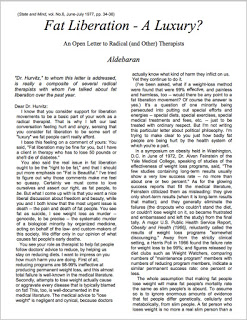 |
| One of the papers archived in the collection |
Do you like to read? Do you own books? What does your bookshelf say about you? Do you take bookshelfies? Looking at people’s reading collections can provide some insight as to what they are thinking about, what inspires them, or about the scope of their interior landscape. It can give context to a person.
The Mayer Collection of Fat Liberation is housed at the Archives & Special Collections at the Thomas J. Dodd Research Centre, part of the University of Connecticut Libraries in Storrs. This is a collection of personal papers and reading donated by Vivian Mayer, who was also known as Aldebaran, and now goes by Sara Fishman. Mayer wrote the forward to Shadow on a Tightrope, Aldebaran was one of the founders of The Fat Underground and Fat Liberator Publications, and although Sara left the movement, she is still in contact with some fat activists. She is a pivotal figure in fat feminist activism. Without her, there would be no me, and you would not be reading this blog post.
Aldebaran/Mayer and Sara to a lesser extent appear extensively in my book, Fat Activism: A Radical Social Movement, though always through secondary sources. She is someone I encountered as an archival presence and her papers mean a lot to me. I tried to go to the Mayer Collection in 2011, it is open to the public though you need to make an appointment. I wanted more insight into her activism but I was thwarted by snow and ice storms and ended up stranded in Hartford for a few days, a great disappointment!
However, all was not lost. Although I never got to read archived correspondence, the finding aid for the archive is pretty extensive and gives you plenty of insight into the material that Mayer was drawing on between 1967 and the mid-1980s. By looking at her books, the periodicals and journals that she lodged with the archive, you can hazard some guesses about the broader contexts through which her style of fat feminism emerged.
It’s clear that she was reading material from the radical left of the 1960s, including Abbie Hoffman, Jerry Rubin and all the usual suspects. There’s also a copy of the Catholic Agitator in there, books on communes and radical pedagogy. Rex Weiner, who began his career in the underground, has a presence, it looks as though he collaborated on a piece with NAAFA in the 1970s. This emphasis on the radical reinforces my belief that fat feminist activism is a force for social change, you could call it a revolutionary movement although, as I argue in my book, it is vulnerable to gentrification and neoconservatism.
Of similar interest, there are books about environmental activism, mostly dating from the 1970s. This brings Elaine Graham-Leigh’s work to mind, how fat people are currently being blamed for climate change. But Mayer’s collection shows that fat feminist activists were probably engaged with early environmental activism too. It’s amazing and depressing what can get overlooked in contemporary fatphobic rhetoric.
Works by the author Ann ForFreedom dominate the feminist materials in the collection. I have gleaned some scraps of information about her online, which may be way off the mark, but the gist of it is that she’s a mover and shaker in the Californian pagan feminist witchcraft scene. What this means for fat feminist activism I have no idea, but I would like to know! Is this also a social movement of witches?! Mayer’s collection also includes underground feminist comics by Roberta Gregory, Aline Kominsky and Diane Noomin – some of my favourites too.
A small group of books are concerned with medical self-advocacy, and navigating healthcare. There is one copy of a Radical Therapy journal, I would have expected to have seen more because this was a movement that incubated The Fat Underground. Perhaps Mayer couldn’t bear to part with her own copies and they were never archived.
There are a few publications that I struggled to make sense of. Last Gasp published The Further Fattening Adventures of Pudge, Girl Blimp by Lee Marrs, which may have been an underground comic and certainly sounds intriguing. There’s also a publication called Slim News, published in Brooklyn at some point, is this an ironic title, I wonder, or some sort of backlash against fat activism?
The Mayer Collection is located within a bigger archival collection of activism and civil rights materials. It still excites me to see this. Where fat people are usually categorised as medical problems, this archive demonstrates that there are other important ways of looking at fat, and that fat people have been at the heart of social change for some time and, hopefully, will remain there.
PS. There’s more about fat activism and archiving in this post.
(c) Obesity Timebomb – Read entire story here.